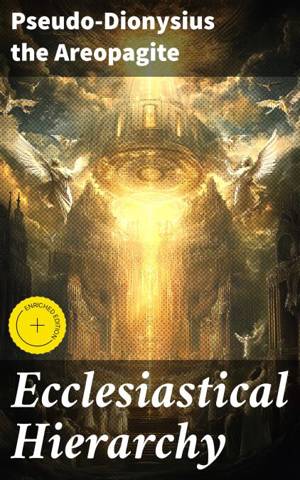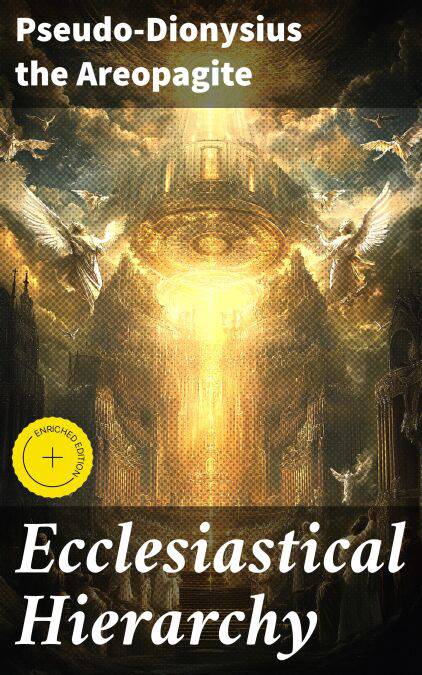
- Afhalen na 1 uur in een winkel met voorraad
- Gratis thuislevering in België vanaf € 30
- Ruim aanbod met 7 miljoen producten
- Afhalen na 1 uur in een winkel met voorraad
- Gratis thuislevering in België vanaf € 30
- Ruim aanbod met 7 miljoen producten
Zoeken
Ecclesiastical Hierarchy E-BOOK
Enriched edition. Exploring the Divine Hierarchy: A Journey of Spiritual Enlightenment and Mystical Insights
Pseudo-Dionysius the Areopagite
E-book | Engels
€ 1,99
+ 1 punten
Omschrijving
In 'Ecclesiastical Hierarchy,' Pseudo-Dionysius the Areopagite presents a profound exploration of the celestial and ecclesiastical orders. This fifth-century text is characterized by its intricate structure, combining Neoplatonic philosophy with early Christian thought. The author employs a sophisticated, mystical language that invites readers into a hierarchical understanding of the universe, emphasizing the relationship between God, angels, and the Church. The treatise delineates the various degrees of hierarchy and outlines the sacramental significance of each layer, thereby illuminating the paths of divine illumination and spiritual ascent within the Christian tradition. Pseudo-Dionysius, whose identity remains shrouded in mystery, is believed to have drawn inspiration from both biblical texts and Platonic ideas, striving to reconcile the tangible aspects of Christian worship with the ineffable nature of divine reality. His works, often used within monastic contexts, reflect the theological turmoil and spiritual aspirations of the early Church as it sought to establish a coherent ecclesiastical identity amid various doctrinal debates. This seminal text is recommended for anyone interested in the intersection of theology, mysticism, and ecclesiology. 'Ecclesiastical Hierarchy' not only enriches one's understanding of the Church's structure but also invites readers to ponder their own place within the spiritual cosmos, making it an indispensable resource for both scholars and seekers of faith.
In this enriched edition, we have carefully created added value for your reading experience:
- A succinct Introduction situates the work's timeless appeal and themes.
- The Synopsis outlines the central plot, highlighting key developments without spoiling critical twists.
- A detailed Historical Context immerses you in the era's events and influences that shaped the writing.
- An Author Biography reveals milestones in the author's life, illuminating the personal insights behind the text.
- A thorough Analysis dissects symbols, motifs, and character arcs to unearth underlying meanings.
- Reflection questions prompt you to engage personally with the work's messages, connecting them to modern life.
- Hand‐picked Memorable Quotes shine a spotlight on moments of literary brilliance.
- Interactive footnotes clarify unusual references, historical allusions, and archaic phrases for an effortless, more informed read.
In this enriched edition, we have carefully created added value for your reading experience:
- A succinct Introduction situates the work's timeless appeal and themes.
- The Synopsis outlines the central plot, highlighting key developments without spoiling critical twists.
- A detailed Historical Context immerses you in the era's events and influences that shaped the writing.
- An Author Biography reveals milestones in the author's life, illuminating the personal insights behind the text.
- A thorough Analysis dissects symbols, motifs, and character arcs to unearth underlying meanings.
- Reflection questions prompt you to engage personally with the work's messages, connecting them to modern life.
- Hand‐picked Memorable Quotes shine a spotlight on moments of literary brilliance.
- Interactive footnotes clarify unusual references, historical allusions, and archaic phrases for an effortless, more informed read.
Specificaties
Betrokkenen
- Auteur(s):
- Vertaler(s):
- Uitgeverij:
Inhoud
- Aantal bladzijden:
- 62
- Taal:
- Engels
Eigenschappen
- Productcode (EAN):
- 4064066466336
- Verschijningsdatum:
- 9/04/2021
- Uitvoering:
- E-book
- Beveiligd met:
- Digital watermarking
- Formaat:
- ePub

Alleen bij Standaard Boekhandel
+ 1 punten op je klantenkaart van Standaard Boekhandel
Beoordelingen
We publiceren alleen reviews die voldoen aan de voorwaarden voor reviews. Bekijk onze voorwaarden voor reviews.








